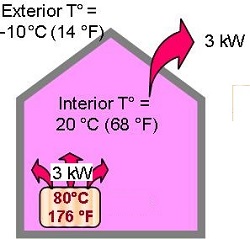To provide heat to the inside of a room, there are 2 solutions:
- Solution 1: each body, with a given temperature, gives off heat if it is in an atmosphere colder than itself.
To provide a heat output in the room to be maintained
at temperature, one solution is to introduce into this room an object hotter
than the atmosphere. We’ll call this object a “heat emitter”.

For an object at a given temperature, the greater the difference with the
ambient temperature, the greater is the heat output given off. As a result, for
a required given output; the less hot the emitter, the larger the surface it
must have:

These 3 emitters give off the same heat output, but as their surface temperatures are different, their size differs.
Thus, for the same supplied output, a low-temperature
under-floor heating system has a very much larger surface than a radiator at 80
[°C] (176 °F).
- Solution 2: to provide a heat output in the room to be maintained at temperature, we can extract air from the room and replace it with warmer air.

